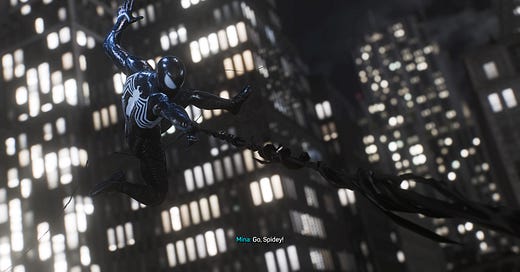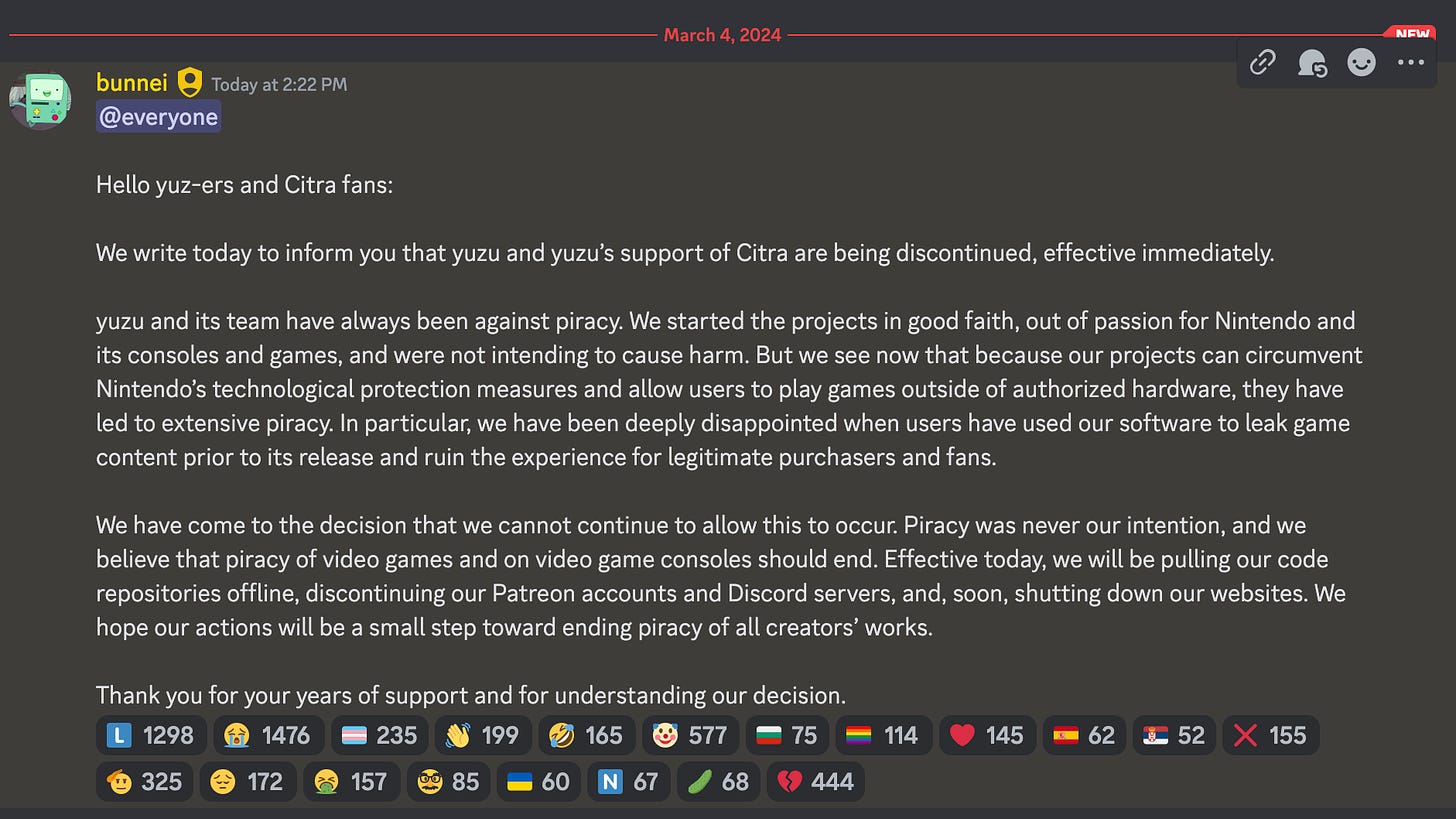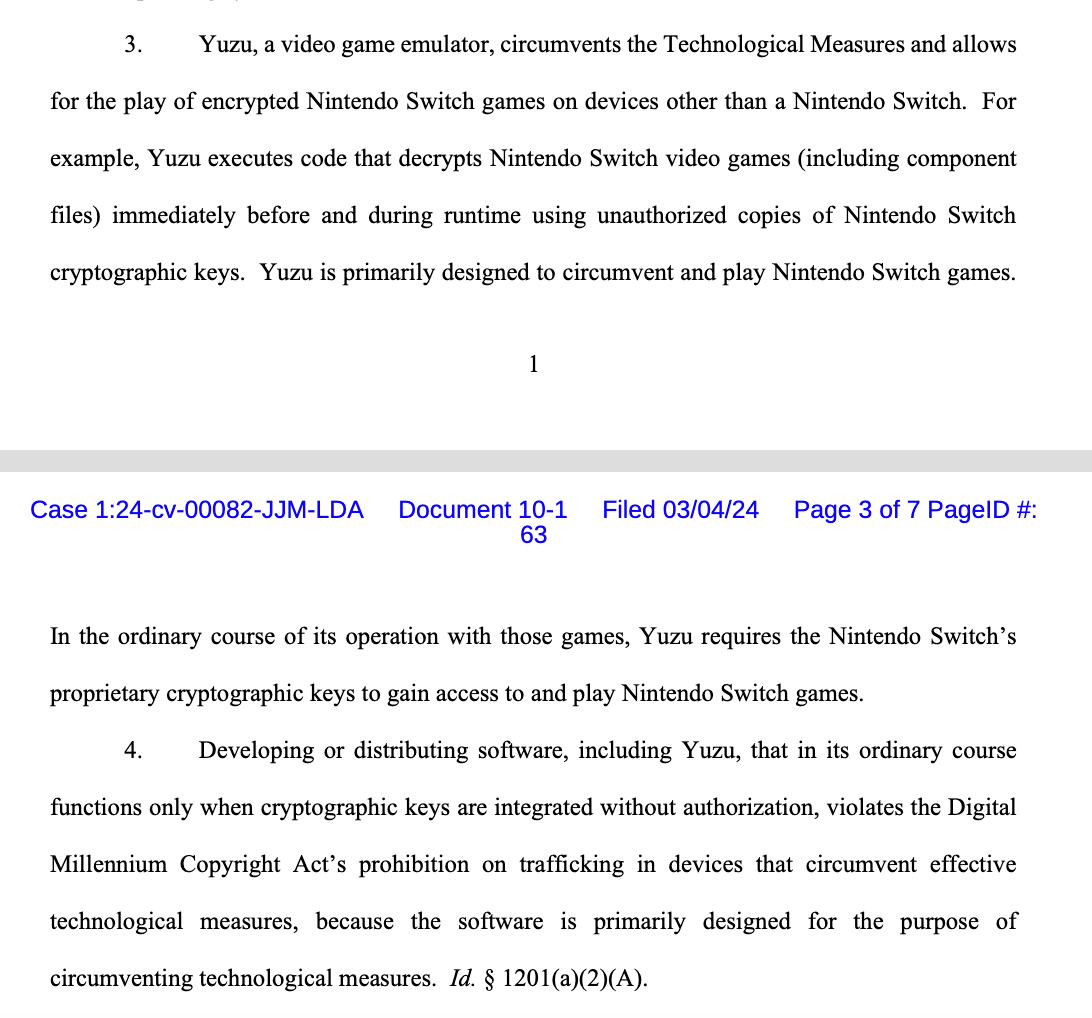Spider-Man 2 facts that Insomniac wants you to know
Plus: The makers of the Yuzu Switch emulator fold in a week, will pay Nintendo $2.4 million
The event was festive. My question was simple. But, in retrospect, the timing could hardly have been more awkward.
On the evening of February 15, I interviewed a parade of developers from Insomniac Games (and one actor) as they stepped off the stage at the 27th annual DICE Awards. The game they’d been working on for years, Marvel’s Spider-Man 2, won six trophies:
Outstanding Achievement in Animation
Outstanding Achievement in Character
Outstanding Achievement in Original Music Composition
Outstanding Achievement in Audio Design
Outstanding Technical Achievement
Action Game of the Year
“Please tell me something about your game that you don’t think people know,” I asked, a softball meant to encourage a hidden detail, a fun fact or something similarly light.
A weird time for the studio
Insomniac’s developers had released a hit game in October, but they hadn’t spoken to the press since an unprecedented ransomware hack on the company’s computers two months later. The attack had exposed personal employee information, details about upcoming games and a roadmap of the studio’s projects for the next decade.
It was a weird time for the studio, community director James Stevenson told me when I asked how the team was coping following the hack. But, he added, the group was supporting each other and getting past it.
That wasn’t everything that Insomniac would be facing. Information learned via the hack had hinted at some mounting pressure on the Sony-owned studio, despite its rep for making PlayStation-selling hits (10 million copies of Spider-Man 2 sold in less than four months; 50 million copies of the series sold since it began in 2018). Hacked messages and presentations showed internal concerns about swelling budgets and a possible mandate from Sony management last fall to lower Insomniac’s headcount.
On Feb. 27, it happened. PlayStation executives announced the elimination of 900 jobs across the gaming division, including some from Insomniac.
“There are no sufficient words to express our feelings about [the layoffs,]” Insomniac stated on social media a day later. “This is a solemn and unprecedented moment for our studio.”
The Insomniac developers I interviewed at DICE last month are still all at the studio.
Through their answers, two things stand out: 1) a warm camaraderie across teams working on disparate facets of the game and 2) ample evidence of a studio that focuses on the smallest details to make something great.
New ideas, many too good to leave out
Spider-Man 2’s epic opening sequence, an interactive battle featuring Spider-Men Peter Parker and Miles Morales fighting a massive manifestation of the villain Sandman, was planned basically from the start, Byran Intihar, senior creative director on Spider-Man 2, told me.
“The first talk we ever had about Spider-Man 2 was about opening with Sandman,” he said. “We didn't know how it would fit in the story. We knew we wanted to open with something that was like, ‘Oh, this feels, on the scale level, like a sequel.”
(He would later say that, sure, they knew they were going to include Venom before that. So maybe Sandman was the second idea they had.
That big moment was planned, but some smaller ones came up along the way.
A critically acclaimed sequence featuring Hailey Cooper, a recurring supporting character who is deaf, “was never planned for the game,” Intihar said.
“Someone just had an idea and they did it,” he said. “There’s a lot of things [like that.] There’s a mission that was created during a game jam that someone did in a couple of days that made it into the game.”
“There are things that are inspired by our team members’ families,” game director Ryan Smith added.
“We have a lot of that as well,” project director Jeannette Lee said. “The team really does show up for that heartfelt moment.”
“The thing is: It doesn't really fit on a schedule,” Intihar said, referring to the game development timeline.
“No,” agreed Lee.
“It doesn’t really, does it?,” Smith said.
“But we make it work,” Lee said.
“The team kind of wills itself to do it,” Intihar said. “If they’re excited about it, we just have to find a way to do it".”
The complexities of animating Venom
“I like the technical achievements to be kind of subtle,” Mike Fitzgerald, director of core technology at Insomniac, said, of the aspect of the game he was involved in.
“One of my favorite things is: We built a ton of new animation technology for all of the Venom tendrils splitting out and coming back together,” he said, referring to the goopy extremities that shoot from symbiote-possessed characters in the game. “Animators were using all-new tools to put all of that together.”
Animation in games often involves rigging human-shaped skeletons, which doesn’t really do it for a Venom-style character, he explained. “You can sort of picture a human character. They have a skeleton, and each part of their body is just mapped to some of those joints. But when you have a tentacle shooting off across the city or onto a building, you can't just animate that same way. Things get stretched out, or their mesh density falls apart. It was a challenge to make sure that things held up to the level of fidelity we want, at real time, making it as good as the movies.”
He added: “I'm really proud of that work, even if maybe as a player you're just invested in the story.”
Little demons in the water
James Ham, an associate animation director, had a specific thing to highlight: a moment when the player is controlling Miles Morales and chases after the villain Martin Li, a pursuit that passes over the water. “We have little demons that come up and try to pull you into the water and drown you,” Ham said. “I haven’t seen any videos of that online yet.”
Bigger picture, senior animation director Bobby Coddington acknowledged a mild tension between the desire for people to just have fun with the game and know what went into it.
“When people look at our games, I hope they just feel it, and they feel like they're Spider-Man and they feel the story,” he said.
“But sometimes I also want to go: ‘There's so much work in there, as far as movie-quality layouts and cinematography and editing. I think it's not out in front, but to us it's very important, too.”
Just listening can be rewarding
“I’m going to call out the work from our dialogue team,” Spider-Man 2 senior audio director Jerry Berlongieri told me.
He wasn’t zeroing in on the conversations that the game’s main characters have but, rather, the modular chatter among Spider-Man 2’s throngs of everyday New Yorkers. Players spend much of the game web-swinging from one skyscraper to the next, but taking a break from that, landing on the sidewalk and just listening can be rewarding.
“There are so many amazing conversations on the street,” Berlongieri said. “Part of what we do is bring New York to life. It’s an enormous effort. There's really funny, interesting moments in the dialogue.”
“You can drop down and just listen to what some of the pedestrians are talking about, and it's kind of a charming system,” he said. “We just say, ‘Spend some time in the city and just kind of listen to some of the nuances that are going on there.’”
Karen Read, Spider-Man 2’s director of audio management, highlighted the chemistry of the full audio team. “It's not just Insomniac. It's our team at Creative Arts from PlayStation, it’s independent contractors—the synergy between our teams, between individuals on this, was really something next level magical.
“It was such an amazing experience that we were all kind of aware of at the time. And I don't know that we'll all be lucky enough to experience something like that again, but the making of it was as phenomenal as the end product.”
One more
“I played Miles as a 13 year old on Disney XD and I kind of grew with Miles,” said Nadji Jeter, the actor who went on to play Miles Morales in Insomniac’s three Spider-Man games.
“Now he's writing his college essay, right? It's been a whole journey of having that in my life.”
Item 2: Switch emulator maker Yuzu to settle with Nintendo for $2.4 million
There will not be a drawn-out legal fight over a Nintendo Switch emulation program called Yuzu that Nintendo recently said was “facilitating piracy at a colossal scale.”
On Feb. 26, Nintendo sued for damages and sought to stop Yuzu and its creators.
Today, Nintendo and Yuzu parent company Tropic Haze indicated that they’re ready to give Nintendo as much of a win as is feasible.
According to terms of a proposed settlement, Tropic Haze will pay Nintendo $2.4 million, cease developing or distributing Yuzu or similar programs, will surrender the domain name yuzu-emu.org, and will delete “all circumvention devices, including all copies of Yuzu, all circumvention tools used for developing or using Yuzu.” (Read the full terms of the proposed inunction against Tropic Haze here.)
Both parties need the case’s judge to sign off.
Shortly after the news of the settlement broke, Yuzu’s lead creator, known online as Bunnei, announced that their team would soon be shutting down Yuzu’s Discord and Patreon, the latter of which was earning just under $30,000 a month from nearly 7,000 members.
“We have been deeply disappointed when users have used our software to leak game content prior to its release and ruin the experience for legitimate purchasers and fans,” Bunnei wrote this afternoon in Yuzu’s Discord chatroom. Yuzu’s Discord was frozen a few minutes later.
The Yuzu emulator allows Nintendo Switch games to be played on Windows, Linux and Android. It was introduced in 2018, a year after the Switch.
In its lawsuit last week, Nintendo argued that Yuzu illegally cracked Nintendo’s security to enable users to operate Switch games on other operating systems and devices. It also targeted Yuzu’s creators, alleging they had to have made illegal copies of Switch games to test them on Yuzu. Nintendo claimed that more than a million copies of its marquee 2023 release, The Legend of Zelda: Tears of the Kingdom, had been illegally downloaded prior to the game’s debut. Many of those copies were played via Yuzu, whose Patreon support soared at that time, Nintendo said.
Nintendo’s pursuit of Yuzu has raised questions about what could happen to other emulators, which are used for preservation and/or piracy. In the settlement, Yuzu is said to violate the Digital Millennium Copyright Act because it, “is primarily designed for the purpose of circumventing technological measures.”
Item 3: In brief
🌏 The World Trade Organization agreed to extending a moratorium on customs duties on electronic commerce (potentially including video games) until 2026, Reuters reports.
Indonesia, the leading opponent of the moratorium, argues that “developing countries lost $56 billion of tariff revenues between 2017 and 2020,” per Reuters. The U.S., however, supports the extension.
🇨🇦 Canada will more closely scrutinize foreign investments in its video game companies to minimize hostile influence on its population, Bloomberg reports.
Per Bloomberg: “National security factors may include the size of a product’s audience, whether it includes in-game chat logs, purchases and microphone or camera access, and prospective investors’ ties to foreign governments…”
🏈 More than 10,000 college athletes have agreed to have their name, image and likeness included in EA’s upcoming college football game, the publisher announced today.
Each athlete will be paid $600 and receive a copy of the game. Over 11,000 are eligible, ESPN reports.
🎮 Microsoft will air a “partner showcase” on Wednesday (1pm ET), featuring a half an hour of gaming trailers and announcements from EA, Capcom and more.
😲 A Willy Wonka event for kids in Glasgow, Scotland that went viral for being terrible has been recreated in Fortnite, Eurogamer reports.
Item 4: “We want to give the fans everything, but we can't.”
Backstage at the DICE Awards, I spoke to other developers in addition to the Insomniac team. I asked them all the same question about what they thought people might not know about their work.
The most impassioned answer I got might be the one from Ramone Russell, product development and communications strategist for Sony’s annual baseball series, MLB The Show .
His answer, about the challenges of making video games, was clearly meant for players, including those who give developers a lot of grif:
“Everything is difficult. And if we haven't done something, it's because we haven't figured out the right way to do it.
“We want to do everything.
“Nobody comes to work in video game development trying to make anyone angry.
“We want to give the fans everything, but we can't. We have a release date. We have a finite amount of resources. So when we miss the mark, it's never because of a lack of effort.
“We're human beings just like everyone else. And sometimes we hit that mark and sometimes we miss the mark. But when we do miss the mark, it's never because we weren't trying hard enough.”











My favorite newsletter on Substack. I know I’ve said this before but going to keep commenting on each post to help the algorithm bless you xx
Another great edition, Stephen, and that's a terrific question to have asked. Can't believe that Sony included Insomniac in the staff cuts. There's literally nothing they could have done differently. It's an absolute shame.